The scholars and connoisseurs of art have the opinion that Gond customs echo their Mesolithic forbearers. The custom of decorating the walls or floors of their houses with paintings is an example that may originate in cave-dwelling traditions of their ancestors. The art of the Gond tribal community in central India is dense yet intricate, rich with meaning. Even though there is no credible history of the origin of Gond painting, many believe that the modern form of Gond painting started as decorative and symbolic art from Dighna. Semiotics of the Motifs in Gond Painting.


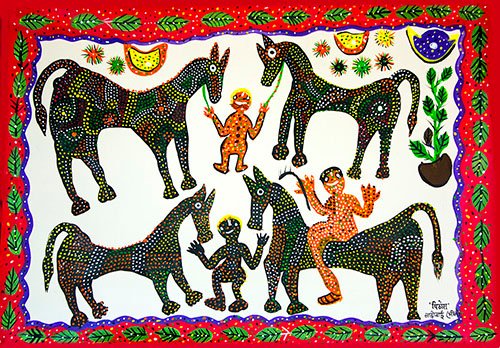

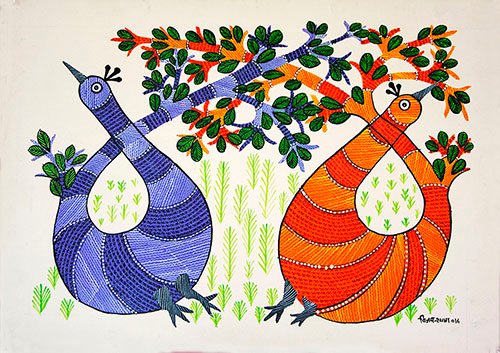
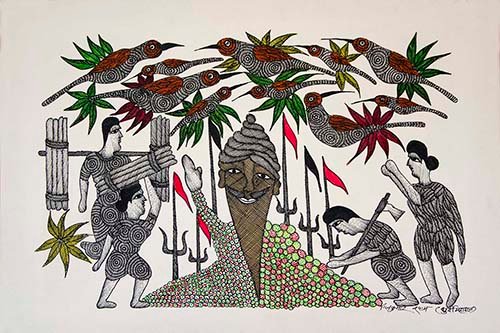

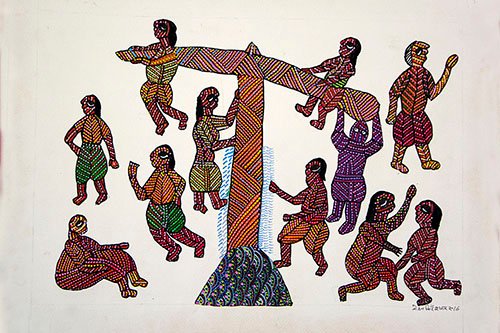
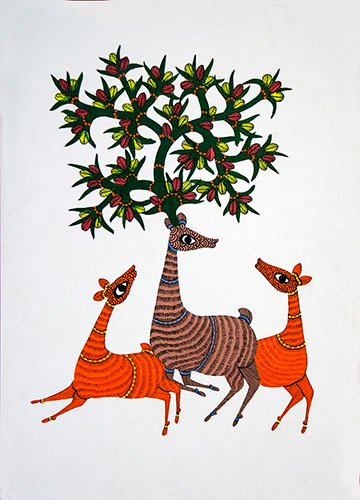
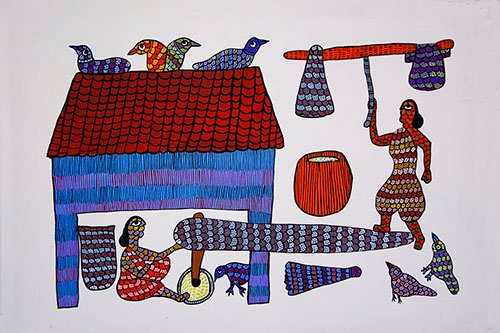
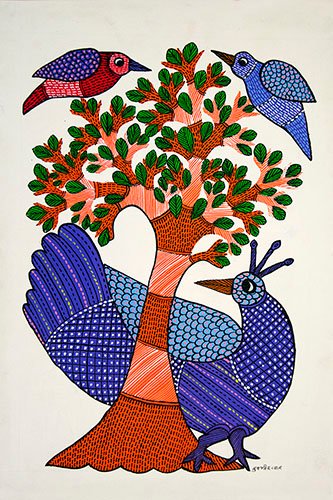

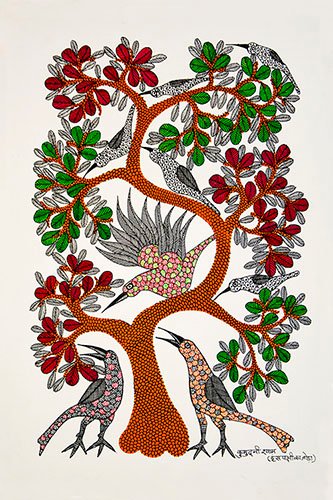


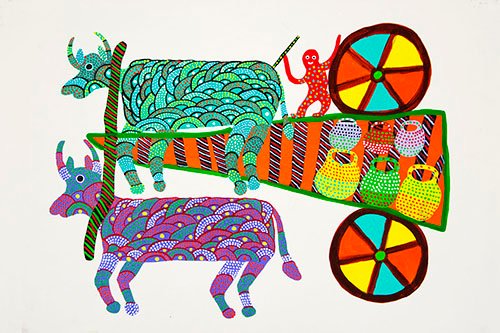

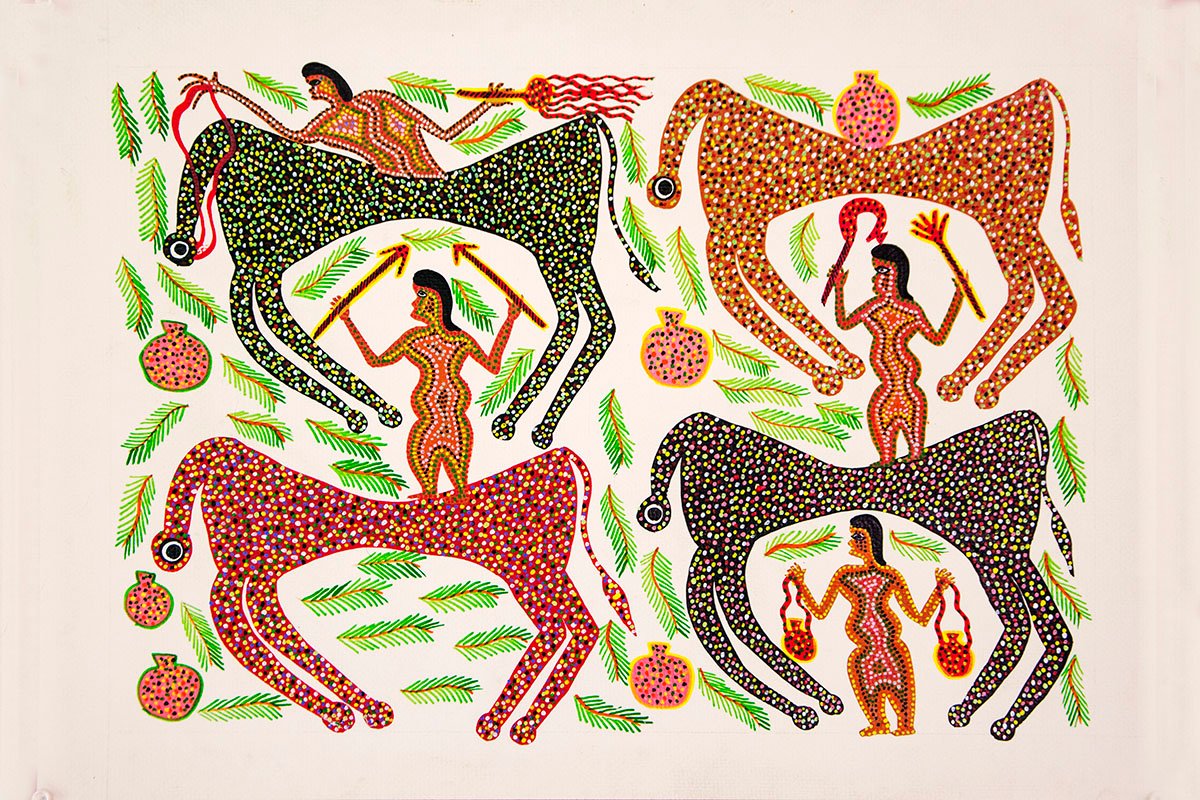
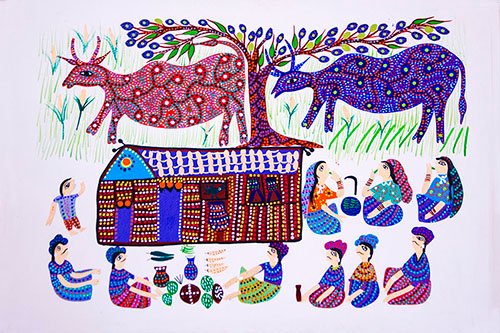
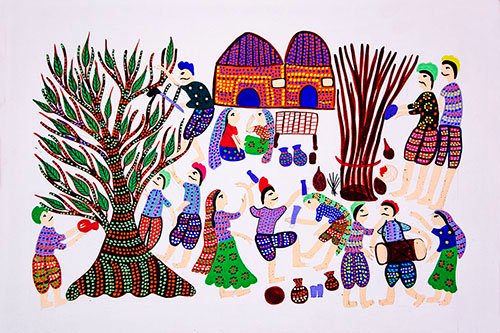
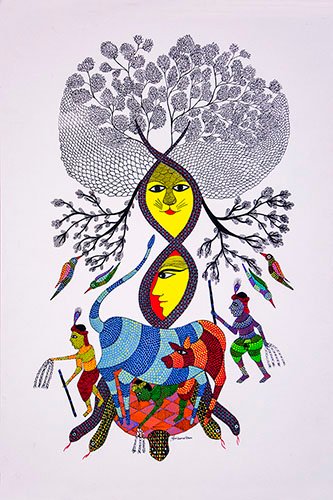
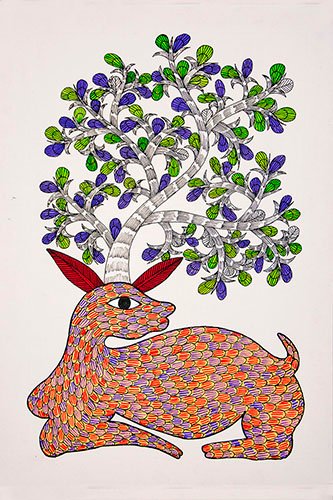

The Gond traditional belief suggests that all such paintings possess the power to fight against evil powers and spread positive vibrations around. In fact, the Gond traditional belief also suggests that ‘viewing a good image brings good fortune’. This belief motivates the Gond people to paint the mud walls and floors of their homes with beautiful images. They usually paint walls or floors during festivals or rituals associated with seasonal changes like the sowing of crops, the onset of rains and harvest or on significant occasions like childbirth, marriage, pregnancy, death, etc. The Pradhan Gonds, a sub-caste of the Gonds, were traditionally assigned to transmit folklore in the form of song in the Gond villages of central India. These Pradhans Gonds, who were also involved in the singing of songs of the glorification of the Gods, goddesses, and nature with a Bana, a traditional single-stringed musical instrument, are assumed to have initiated the tradition of Gond paintings. Perhaps, in the act of transmission of art, culture and traditions, the Pradhans were involved in the translation and transformation of these songs into images of good fortune.
Padmaja Shrivastava, a leading tribal art promoter, believes that it was during the Gond Kingdom when the Pradhan Gonds were assigned to entertain the Gond kings. Some historians have the opinion that Pradhan Gonds were the professional musicians, story-tellers and genealogists. They used to keep and carry the collective beliefs of the Gond tribe in the form of stories for centuries. Later, these Pradhans transformed the songs to images. In the Gondwana region, the unmatched creative vision has been shown by the Gond tribe. Gond tribal walls come alive with vibrant depictions of local flora, fauna, and
Gods such as Marahi Devi and Phulvari Devi (Goddess Kali), fantastical birds, anthill-covered alligators, spirits, humans, and long-snouted crabs (Bharadwaj, 2014). The Gond paintings, developed by Pradhans in Patangarh village, Dindori District, Madhya Pradesh, were initially painted on mud walls with natural colours. Most of the subjects of Gond paintings were inspired by nature, wildlife, religious belief, mythology, and folktales. They painted asymmetrically and lacked details. Later in the middle of the 1980s, under the leadership of Jangarh Singh Shyam, the subject, colour, medium of painting and motif of Gond paintings had a sea change. The painting on canvas, use of acrylic colours, experimentation of contemporary subjects along with traditional folklore, uses of modern and painters’ signature motifs have found dominance in the traditional paintings of the Gonds. Over the years, the ‘Gond’ style has become an autonomous art form and has achieved global recognition.
From Dighna to canvas painting, the traditional images and religious beliefs of Gond people emerged as the cultural identity of the tribe and travelled from their tribal settlements to exhibitions of modern art galleries. It is said that the process of transition started in the early years of the 1980s when a few creative Pradhan Gonds came out of their traditional profession of the bardic priest performing Gond ceremonies to narrate oral histories, religious and folk stories and their relations with mother earth with colourful visual art. From the traditional mud wall to canvas, natural to artificial colours and traditional stories to contemporary themes, the tribal visual art of central India took a big leap with the commercialisation of the art. Later, the Gond painters went on to use animated films, ink on papers and silkscreen prints.
The Gond painting, emerging out of the traditional Dighna painting to canvas painting, may have found spaces in exhibitions or art galleries or walls of drawing rooms or hotels, etc. over time, but authentic information and literature of its origin, development, and techniques of Gond painting are found to be minimal. The oral literature of the origin and development, passing of painting techniques from generation to generation and getting restricted to a small community of painters and area, have been the hurdles for the slow growth of Gond painting.
The Gond tribe, predominantly residing in the central and eastern regions of India, boasts a rich cultural heritage that finds expression through various art forms, including their distinctive music. Gond tribal music is deeply rooted in their traditions, serving as a means of preserving their unique identity and narrating their stories.
The lyrics of their songs often revolve around nature, folklore, and daily life, reflecting a close connection with their surroundings. Gond music plays a crucial role in their rituals, ceremonies, and celebrations, fostering a sense of community and shared history.
Pata Singing in Gonds is an art form which depicts valour of the Gond kings and queens. Prem Shah Marwai is one of the renowned singer of Gondi language who has won awards and recognition like. Gondwana Swarlahiri and Hirasuka Pataleer awards for his contribution to the culture of the Gonds. Beside this their Karma dance can be included in form of visual representation or through diorama.
The themes of the Karma songs are about life. In Lalpur Village (Mandla district) many professional groups perform the Karma to the accompaniment of instruments like the gudum, timki, nagada. Sheikh Gulab, a scholar and performer from Mandal District began documenting the Gond oral narratives – the myths, legends, folklore and songs and training dancers some decades ago. Now, one of his students, Lalta Ram Marawi, continues his work.

As per the story, the entire method of preparing this musical instrument was explained to the Gond king by Bada Dev himself in dream. The king shared it with his younger brother, who in turn, prepared the instrument from the wood of Saja tree and also made a bow (Hathauri) to play it. As he sat in meditation under the Saja tree a bird "bharahi” began to sing while flying in the sky. The Pardhan moved his Hathauri imitating the movements of the Bharahi bird and the instrument began to play a divine music. Bada Dev was pleased by the music and appeared from the Saja tree and blessed the Gonds with prosperity and happiness. This instrument is a 15-18" long stringed musical instrument, but to bring out the great importance in the myth and Gond Me and its relation to Saja tree and Bada Dev it has been envisioned as an installation with the help of different mediums iron, grass, bamboo, Paper Mache, colour and a huge hollow tree trunk.
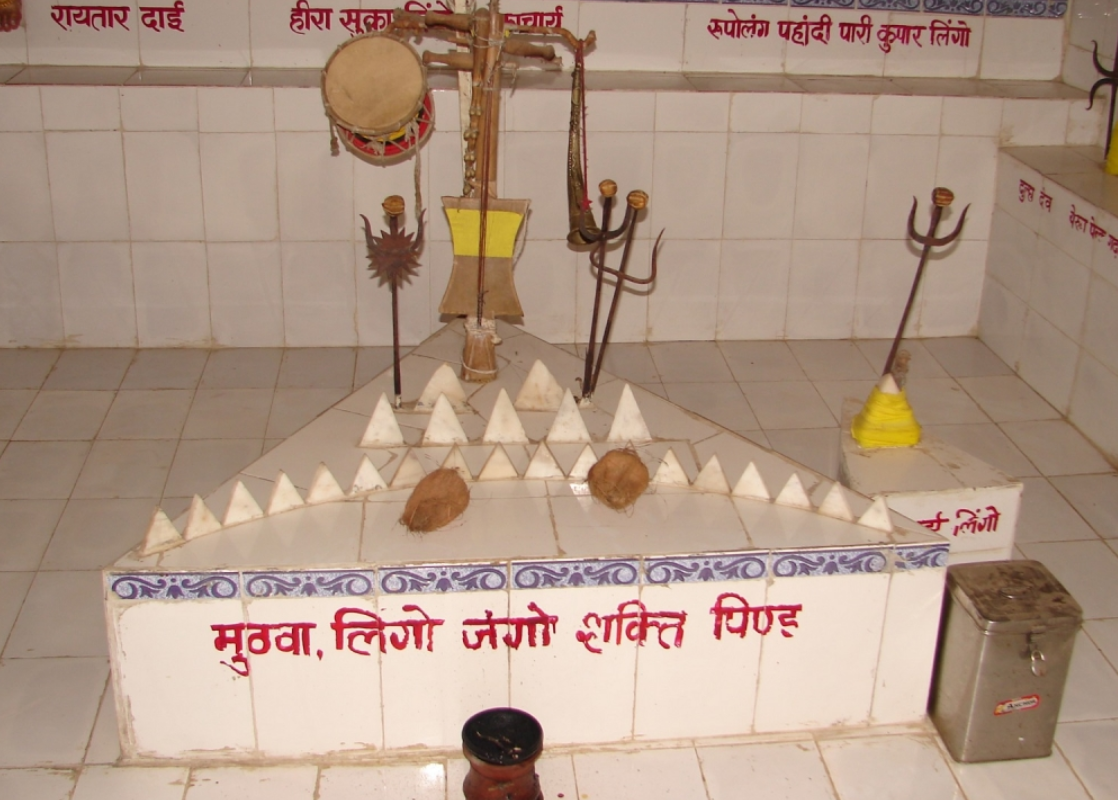
Baana is the most important musical instrument of the Gond tribe. According to the Gond myth, the youngest of Gond brothers created and played this String instrument to propitiate their God. Bada Dev, who had angrily entered a Saja tree, since then this younger brother known as Pardhan was assigned to invoke Bada dev on every important occasion. Even today the Pardhan Gonds, who are priests & storytellers for Gond community invokes Bade Dev by playing Bana and also narrates the stories of Gond kings and also facilitates the salvation of the deceased by singing the ritualistic songs

The Gonds express themselves through different forms of dance like the Saila, Rina and Dadariya, which are performed during festivals. The Saila was once performed with swords. Now these have been replaced by sticks. The Dadariya is sung when the groom arrives and again when she leaves with her groom. But it is the Karma that can be performed any time of the year. When a guest arrives, the family gathers and they all do the Karma dance together.
The Gond tribe predominantly follows animistic religious practices, rooted in a deep connection with nature and the elements. Their belief system involves worshiping a pantheon of deities that represent various aspects of the natural world, such as Bada Dev (the supreme god) and Baradeo (the god of crops). The Gonds believe in the spiritual significance of their surroundings, including forests, hills, rivers, and animals. Rituals and ceremonies play a crucial role in their religious expression, and festivals are marked by vibrant celebrations that reflect their close relationship with agriculture and communal bonds. While animism forms the core of Gond spirituality, influences from Hinduism and other neighboring religions can also be observed in certain practices, showcasing the dynamic nature of their religious beliefs.

Chougan is a common sight in Mandala region of Madhya Pradesh. It is a raised platform where dwells all Gods and Goddesses worshipped by tribes. In Choughan, a ladder can be seen known as “sarag naseni”, it is believed that a person having pure soul and godly attributes can follow the path to the heaven. Having possessed pure soul is only eligibility to climb the ladder. According to an episode in the epic Mahabharat only dog reached the doors of heaven. In Choughan 'sarag naseni' is offered to the Goddess.
According to Gond myths, Lingo is the youngest brother of Gonds and is respected as protector. Though, the story about Lingo is not prevalent among the Gonds of Madhya Pradesh, but there is a mention in the story about origin of Narmada and in the episode when Bhimsen fails to stop river Narmada. Lingo Dev is a principal God of Gond tribe and its branches like Madia, Dorfa, Dhurva, Halba and especially Murias. The myths associated with Lingo Dev mention about freeing his Gond brothers from a cave and then gifting them fire, music, agriculture, Ghotul and marriage.
According to a myth, Lingo was born on the yellow flowers of Pahindi in Dhavalgiri. The musical instruments (gift of Lingo to humans), Ghotul and his very own unique appearance find mention in the myths. He holds a stick in his hand, an axe on his shoulder, wears a white turban that shines bright. The Murias invite Lingo at the time of marriage saying that "this is your own marriage ceremony".
Finely carved wooden pillars of Lingo Dev Gudi depict insects, creatures and various gods and goddesses. The Gudi has no image of Lingo, but his Anga is decorated with silver strips and there is a snake figure with hood between them.
Music instruments are also placed at Gudi as they are supposed to be precious gifts of Lingo Dev to mankind. These instruments are used from time to time on various occasions.
At present there are a number of artists who through their paintings of the Gond way of life are generating an interest in these traditions. For the most part these artists are Gond Pardhans, one of the branches of Gond community. Jangarh Singh Shyam was the first Gond Pardhan artist and the present genre of Gond painting is now called Jangarh Kalam.
The scholars and connoisseurs of art have the opinion that Gond customs echo their Mesolithic forbearers. The custom of decorating the walls or floors of their houses with paintings is an example that may originate in cave-dwelling traditions of their ancestors. The art of the Gond tribal community in central India is dense yet intricate, rich with meaning. Even though there is no credible history of the origin of Gond painting, many believe that the modern form of Gond painting started as decorative and symbolic art from Dighna. Semiotics of the Motifs in Gond Painting.
The Gond traditional belief suggests that all such paintings possess the power to fight against evil powers and spread positive vibrations around. In fact, the Gond traditional belief also suggests that ‘viewing a good image brings good fortune’. This belief motivates the Gond people to paint the mud walls and floors of their homes with beautiful images. They usually paint walls or floors during festivals or rituals associated with seasonal changes like the sowing of crops, the onset of rains and harvest or on significant occasions like childbirth, marriage, pregnancy, death, etc. The Pradhan Gonds, a sub-caste of the Gonds, were traditionally assigned to transmit folklore in the form of song in the Gond villages of central India. These Pradhans Gonds, who were also involved in the singing of songs of the glorification of the Gods, goddesses, and nature with a Bana, a traditional single-stringed musical instrument, are assumed to have initiated the tradition of Gond paintings. Perhaps, in the act of transmission of art, culture and traditions, the Pradhans were involved in the translation and transformation of these songs into images of good fortune.
Padmaja Shrivastava, a leading tribal art promoter, believes that it was during the Gond Kingdom when the Pradhan Gonds were assigned to entertain the Gond kings. Some historians have the opinion that Pradhan Gonds were the professional musicians, story-tellers and genealogists. They used to keep and carry the collective beliefs of the Gond tribe in the form of stories for centuries. Later, these Pradhans transformed the songs to images. In the Gondwana region, the unmatched creative vision has been shown by the Gond tribe. Gond tribal walls come alive with vibrant depictions of local flora, fauna, and
Gods such as Marahi Devi and Phulvari Devi (Goddess Kali), fantastical birds, anthill-covered alligators, spirits, humans, and long-snouted crabs (Bharadwaj, 2014). The Gond paintings, developed by Pradhans in Patangarh village, Dindori District, Madhya Pradesh, were initially painted on mud walls with natural colours. Most of the subjects of Gond paintings were inspired by nature, wildlife, religious belief, mythology, and folktales. They painted asymmetrically and lacked details. Later in the middle of the 1980s, under the leadership of Jangarh Singh Shyam, the subject, colour, medium of painting and motif of Gond paintings had a sea change. The painting on canvas, use of acrylic colours, experimentation of contemporary subjects along with traditional folklore, uses of modern and painters’ signature motifs have found dominance in the traditional paintings of the Gonds. Over the years, the ‘Gond’ style has become an autonomous art form and has achieved global recognition.
The Gond painting, emerging out of the traditional Dighna painting to canvas painting, may have found spaces in exhibitions or art galleries or walls of drawing rooms or hotels, etc. over time, but authentic information and literature of its origin, development, and techniques of Gond painting are found to be minimal. The oral literature of the origin and development, passing of painting techniques from generation to generation and getting restricted to a small community of painters and area, have been the hurdles for the slow growth of Gond painting.